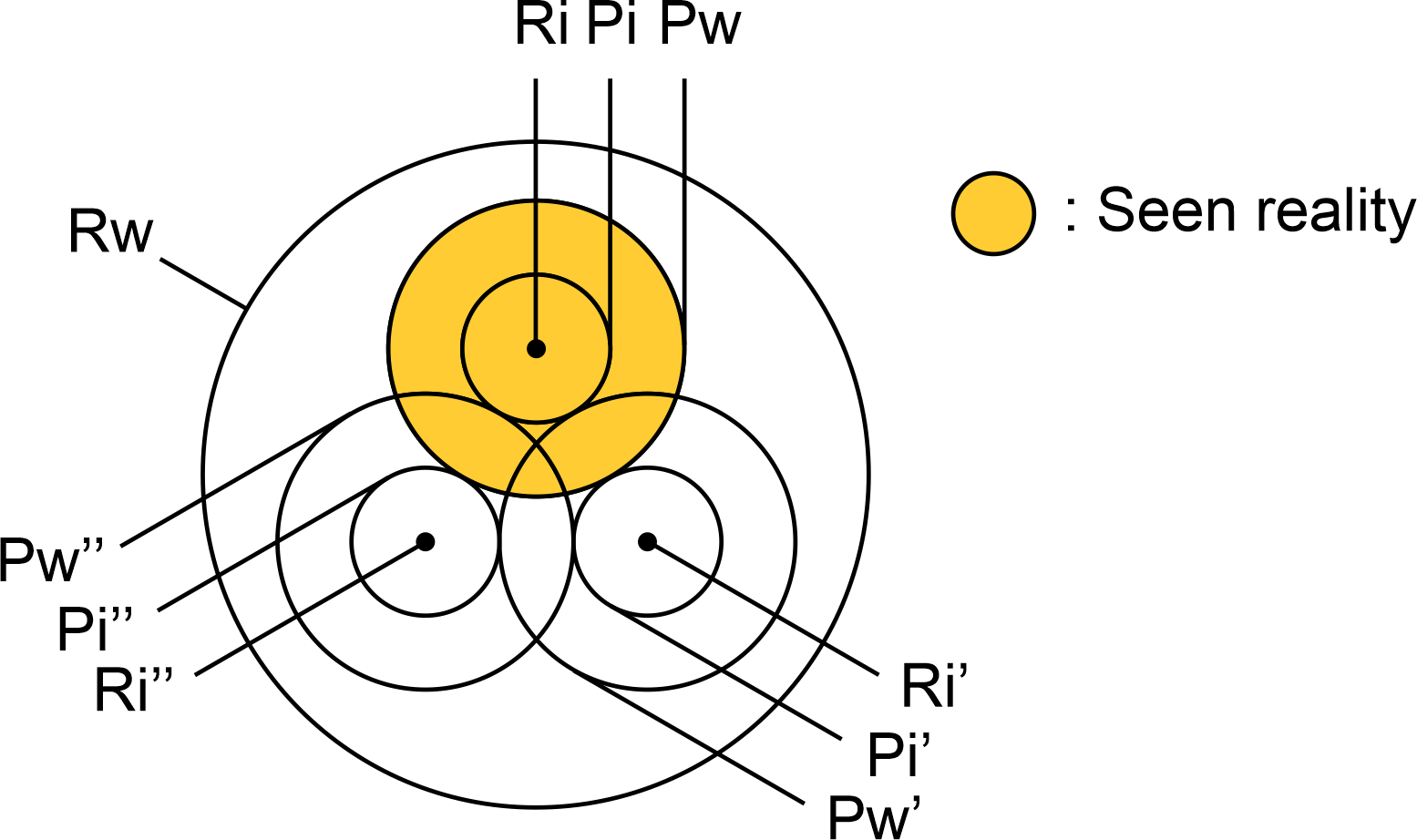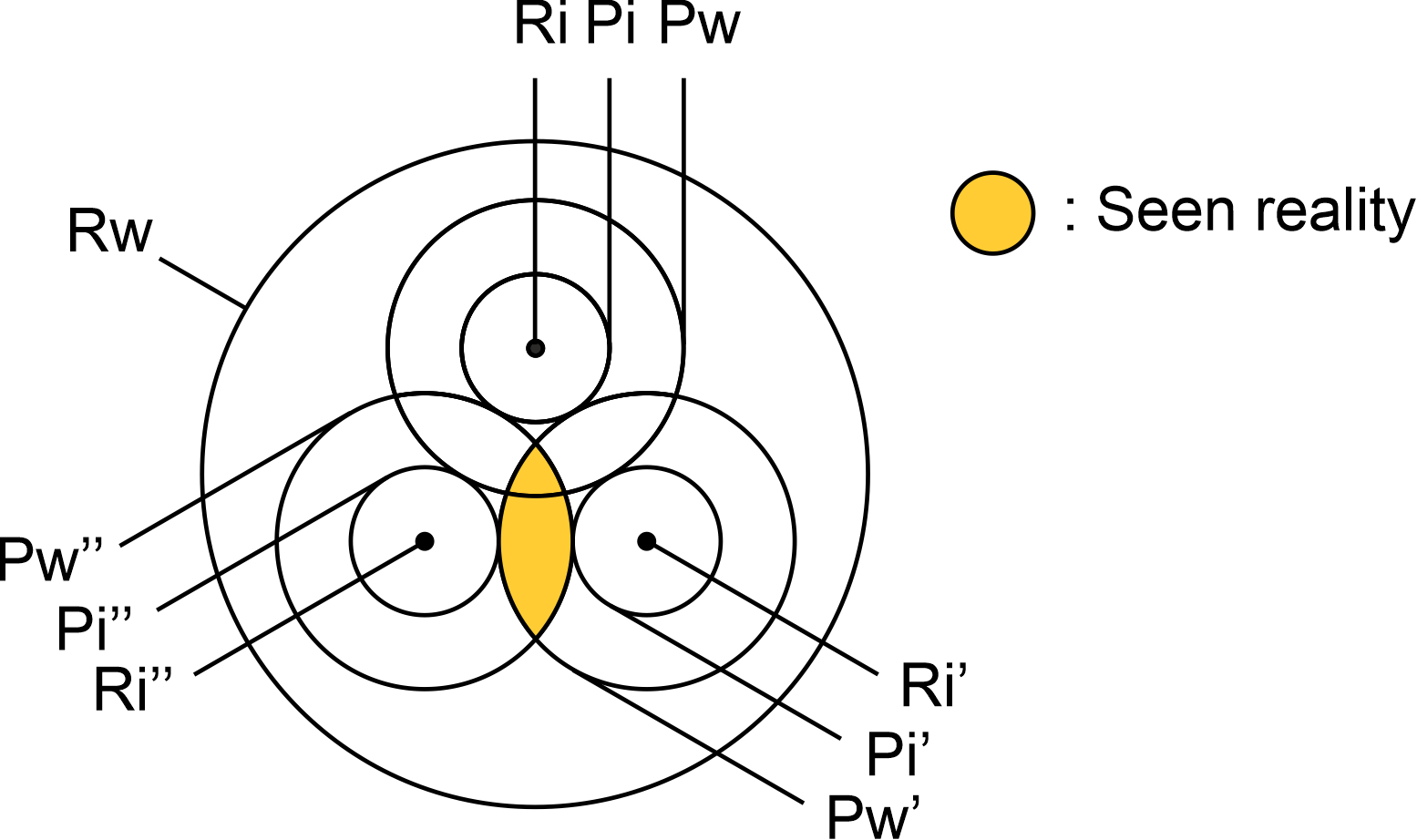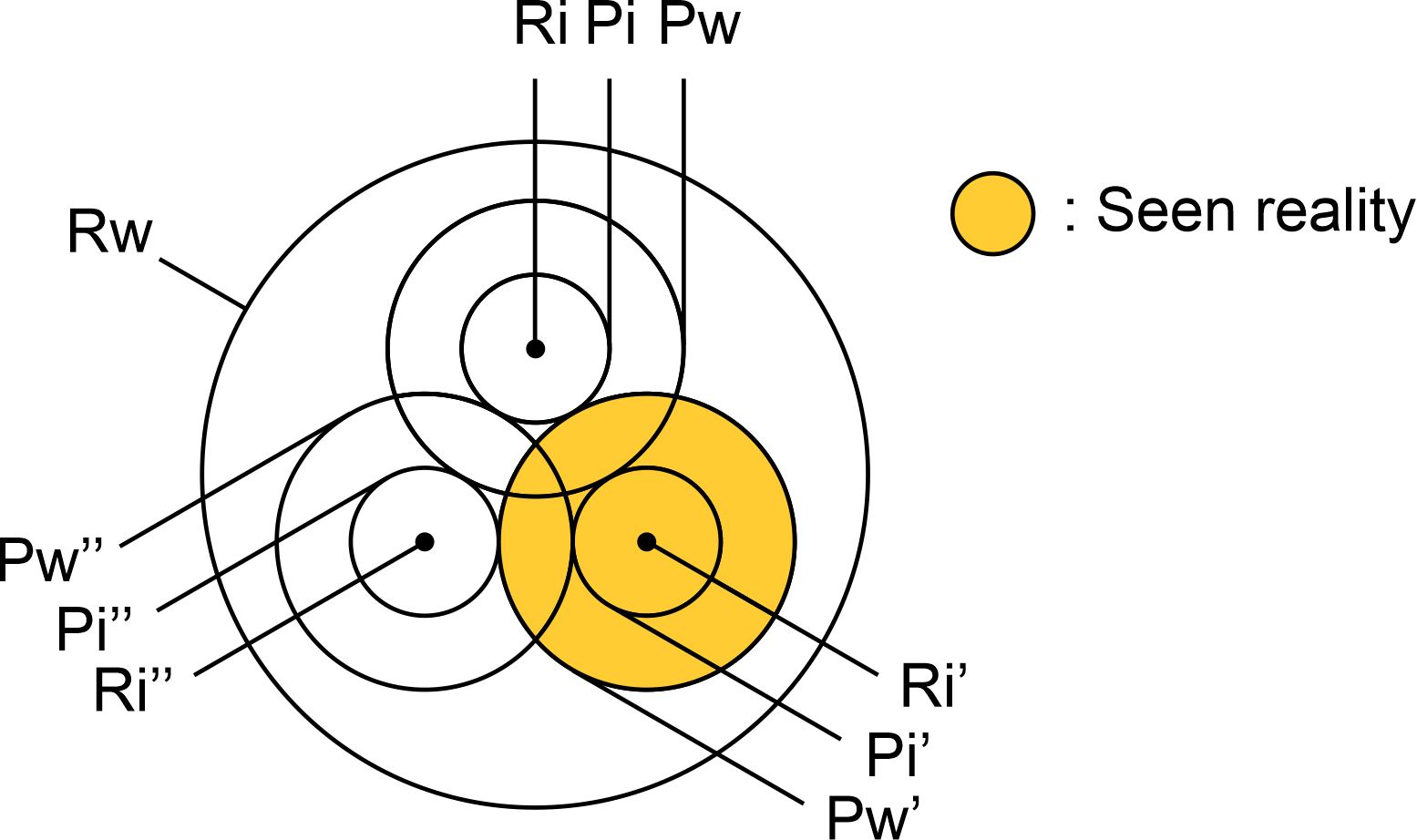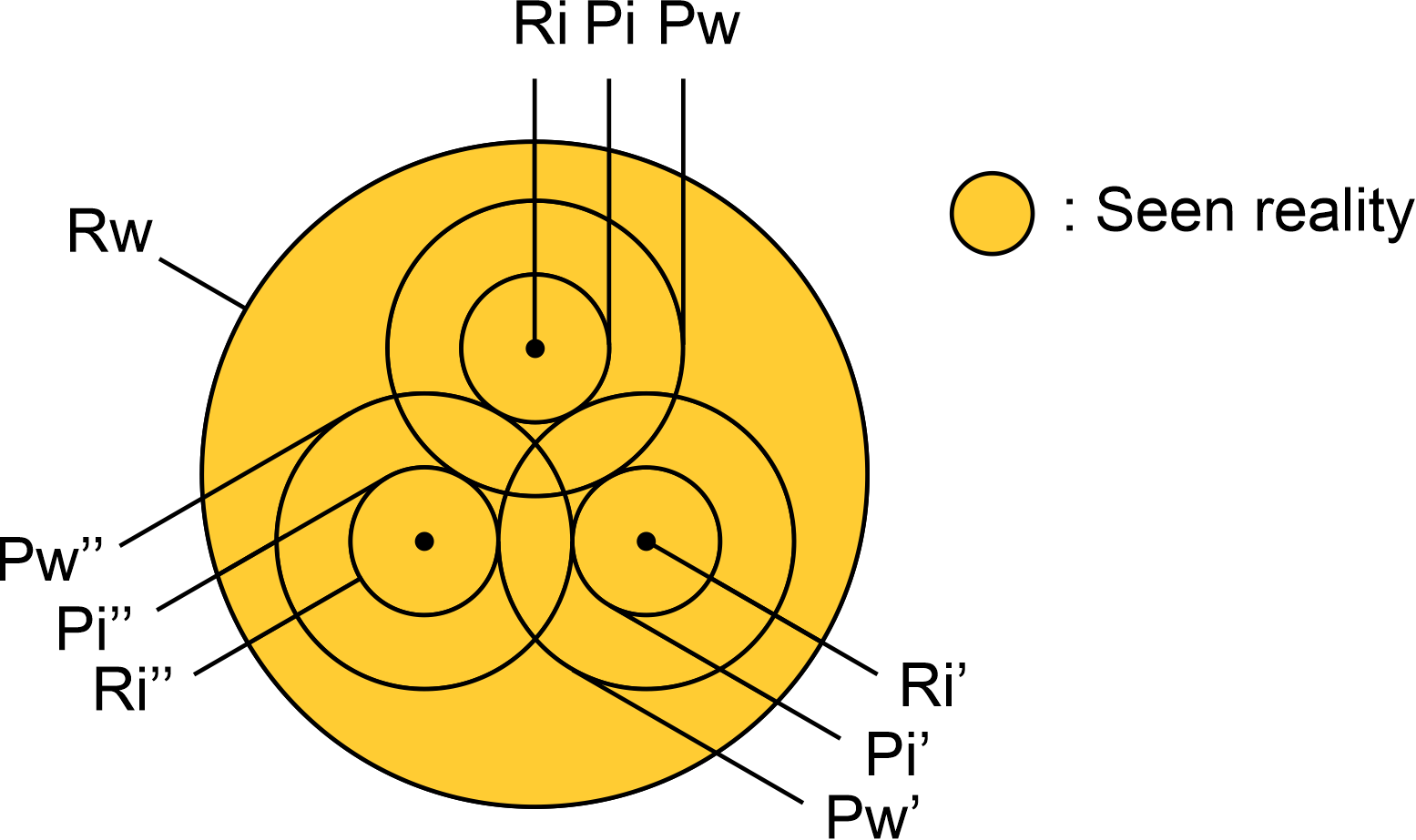- Title: Contemplations, Person Perspectives.
- Author: Arvindus.
- Publisher: Arvindus.
- Copyright: Arvindus, 2012, all rights reserved.
- Index: 201205091.
- Edition: html, first edition.
Introduction
In this contemplation we shall have a look at four different 'person perspectives', as they are called. Of these four the best known shall most likely be the first person perspective and the third person perspective. To form a well known base these two shall be dealt with before contemplating the two other perspectives. These latter regard the second person perspective and the zeroth person perspective. The present contemplation however shall be started with a consideration on the term 'person perspective' so that what follows can be understood in a clear way.
Person Perspective
Perspective
The English word 'perspective' comes from the Latin 'perspiciō', which carries meanings pertaining to seeing (either literally with the eye or figural with the mind).1 It is a compound word consisting of 'per' and 'speciō'.2 The prefix 'per' adds the idea of 'through' to the word to which it is attached or gives that word an intensification.3 Now with 'speciō' meaning 'to see' (with the eye) or 'to consider' (with the mind),4 can 'perspiciō' be understood as 'seeing through' or as 'intensely seeing', and this both literally and figural. These meanings are also still conveyed in the English word 'perspective'. A perspective regards basically an intense seeing of reality through appearance. A two-dimensional drawing for instance is seen through as two-dimensional when it is drawn in a three-dimensional perspective.5 Here the three-dimensional is taken (intensely) as the real state of the drawn object and its two-dimensional appearance on paper is seen through. This meaning is also valid in the figural sense of perspective. Also when seen with the mind is in a perspective appearance seen through and reality intensely looked at.6
Person
In a perspective is reality intensely seen, through its appearance. This contemplation focuses however not just on any perspective but especially on person perspectives. Now this English word 'person' can be traced back to the Latin 'persōna'.7 This Latin word is often thought to stem from the Etruscan 'phersu', from which it is thought to have gained its root meaning of 'mask'.8 Now a mask is obviously a given par excellence of appearance, hiding reality. So when a person, a mask, intensely sees reality through reality's appearance, then it cannot be otherwise than that that seen reality is seen through the eyes of appearance itself. It may be opposed that a mask has holes through which the masked one can see as if he were not wearing a mask at all. However such a mask is not a complete mask, for the masked individual could then still be recognized by the color and form of his eyes. But looking through a complete mask the outlook will always be conditioned by the qualities of the mask. Here the term 'mask' must be understood in the meaning of 'cloak'9 or 'veil'.10 Thus is in a person perspective reality intensely seen, through reality's appearance, in the way reality appears to the regarded person. Let us elucidate this with an example. Imagine two individuals facing each other while wearing full masks or veils to remain thus unrecognized. When one individual succeeds in unmasking the other then he will still see the other in the color of his own veil and he will still not see the other individual as he really is. So in a personal perspective is reality intensely seen through its appearance in the way it appears. With this preparatory work done we may now continue to contemplate the different person perspectives.
First Person Perspective
We will start our contemplation on the preconceived four types of person perspective with the first person perspective. The term 'first person perspective' may sound familiar as it is used regularly in philosophical but also in plain everyday language. It can be said that in a first person perspective a person takes for real only what has been presented to him through his own personal experience. This is a very subjectivistic and when radical even a solipsistic position. Reality for a person taking a first person position is dependent fully on his own experience and testimonies of others are not given any validity. This is what 'first' in 'first person perspective' refers to. The experiences of the perspective taking person come first. In a first person perspective is reality apparently seen in one's own experiences. In figure 1 is such a first person perspective symbolized.

Figure 1: The first person perspective.
In this figure 1 we see three points, three smallest circles and three medium circles within one largest circle. Of these does the upper point symbolize a real individual (Ri). The upper smallest circle symbolizes a personal individual (Pi). And the upper medium circle symbolizes a personal world (Pw). The space between the point and the smallest circle symbolizes the inner experiences which have their place between the real individual and the mask of the personal individual. The space between the smallest circle and the medium circle symbolizes the outer experiences between the personal individual and the personal world.
These symbols are repeated with the lower left and right points, the lower left and right smallest circles and the lower left and right medium circles. These are indicated similar with the aforementioned upper symbols, with the difference that one or two accents are added. The choice for accents instead of a numbering serves a specific purpose. Had the upper and other symbols been numbered then all three personal individuals and their personal worlds would have been given equal importance and status. With this it would not be possible to show the roles that other individual persons may play when a certain individual person takes a specific perspective. Persons Pi' and Pi'' stand in service of the perspective of Pi. This is what the accents symbolize.
There are other symbols that have not been clarified yet. Figure 1 also shows one largest circle, holding within its border all other symbols. This circle symbolizes the real world (Rw). It is obvious that personal individual worlds are smaller than the real world. No person ever experienced everything there is, but every person experienced a part of it. Note that the real world is containing both the outer as the inner worlds of individuals.
The last symbol to be clarified then is the color. Spaces which are colored in figure 1 symbolize what is seen as reality by an individual when taking a specific perspective.
What further needs to be noticed is that the experiences of Pi, Pi' and Pi'' overlap each other partly, but not fully. They share certain common experiences, though most experiences they do not share with each other. In figure 1 only the external experiences are overlapping. It may however also happen that inner experiences have an overlap. This is a peculiar remark because it means that one inner man may share the same inner world with that of another. Here however there is no room to show the plausibility of the remark, except then through the logic of the figure itself.
All of the above clarified symbols are valid also for further figures to come. However under this paragraph we are dealing with figure 1, symbolizing the first person perspective. And what was said about this perspective was that only own personal individual experiences are seen as real, granting no validity to the reports of others. This we see symbolized in figure 1. Only the spaces between Ri and Pw, regarding the inner and outer personal experiences of Pi, are colored. The overlap areas where Pi' and Pi'' have the same experiences as Pi are seen as reality too, but Pi' and Pi'' might as well not have been present at all. They are simply ignored by Pi.
Third Person Perspective
The term 'third person perspective' shall probably sound just as familiar as the term 'first person perspective'. In a third person perspective are the shared experiences of two persons who are not the perspective taking person taken as leading in valuating reality. This is an objectivistic, and with that anti-subjectivisitc, position. The anti-subjectivism shows in two ways. Firstly; for a given to be considered objective it cannot be dependent on the experience of the person taking the perspective, for then it would be subjective. It may be part of the person's experience but it cannot be dependent on it. And secondly; if that given was further experienced by only one person who is not the one taking the regarded perspective then the reality of that given could very well be dependent on that other person's subjectivity. So there must be at least one other person, not taking the perspective, experiencing the very same given. Therefore are the shared experiences of two persons who are not the perspective taking person taken as leading in valuating reality. In a third person perspective is reality apparently seen in the seeing of reality by (at least) two persons. This seeing of reality by (at least) two persons by a third person is what 'third' in 'third person perspective' refers to. The experiences of the person taking this perspective come third, after those of the two other persons. This third person perspective is symbolized (with the same symbols as explained earlier) in figure 2.

Figure 2: The third person perspective.
In this figure is only the overlap of the experiences of Pi' with those of Pi'' colored. It is this area which is seen as real from the third person perspective of Pi. Indeed there is an overlap of experience with that of Pi too, but this holds no further relevance for what is seen as reality.
Second Person Perspective
Unlike the terms 'first person perspective' and 'third person perspective' is the term 'second person perspective' hardly ever used, neither in philosophical nor in everyday language. However the concept fits in logically between those of the first and the third person perspective. Not just with regards to its name, but in a way also with regards to its content. For in a second person perspective is not one's own experience taken as leading in determining reality, and neither is the shared experience of two other persons, but is the experience of one other person taken as such. In a second person perspective are the experiences of another person seen as reality. We see this perspective being taken when a person submits his experiences of and considerations on reality totally to those of another person. The experiences of the authoritative other person may be part of the own experiences of the person taking the second person perspective or not, but the latter's own experiences will not be counted for in valuating reality. In a second person perspective reality is apparently seen in the seeing of reality of another person. Placing one's own experiences as second is what 'second' in 'second person perspective' refers to. We see this perspective symbolized in figure 3.

Figure 3: The second person perspective.
In this figure we see that only the spaces between Ri' and Pw', symbolizing the inner and outer experiences of Pi', are colored. There is an overlap with the experiences of Pi, but these are not relevant in determining reality.
Zeroth Person Perspective
The term 'zeroth person perspective' will sound as unfamiliar as the term 'second person perspective' does, and beyond that perhaps even sound a bit unusual. For with a count of givens such as persons we are used to start with the first. We count 'the first person, the second person, the thrid person, etcetera', but never 'the zeroth person, the first person, etcetera'. We usually count with referents, not with inferents.11 Now as has been thematized in the previous paragraphs do 'first', 'second' and 'third' refer to the place of importance of the perspective taking person in relation to those of other persons for the valuating of truth. In the first person perspective the perspective taking person comes first. In the second person perspective he comes second. And in the third person perspective he comes third. In the zeroth person perspective however there is no person taking perspective and valuating reality. Now as has been thematized earlier can a person actually be understood as a mask, a cloak or a veil. And this mask or veil is on the one side hiding the real individual and on the other side hiding the real world. It makes only the personal individual and the personal world visible. Now when this person or veil slides away do also this personal individual and personal world slide away. What remains then is the real individual and the real world. Reality then is seen as it is. Reality then is not seen subjectively as in the first person perspective, nor objectively as in the third person perspective, and nor authoritatively as in the second person perspective. Also is reality in the zeroth person perspective not seen apparently as is the case in the first, second and third. In the zeroth person perspective is reality really seen. In fact; due to the lack of a person being present can the zeroth person perspective be considered as being not really a person perspective at all, but more as just a plain perspective. We see this perspective symbolized in figure 4.

Figure 4: The zeroth person perspective.
In this figure we see all spaces colored. Basically this is so because there is only one space left, namely the space between Ri and Rw. Pi and Pw have fallen away with the falling away of the veiling person. So everything falling within the space between Ri and Rw is seen as reality. And this includes the spaces between Ri' and Pw' and Ri'' and Pw''. This also means that Ri' and Ri'' stand unveiled for Ri. For themselves and for each other they may still keep up their veil, but Ri sees through these. The zeroth person perspective is the perspective of the so called 'enlightened' individual or of the metanthropos.12
Conclusion
In this contemplation we intended to have a look at four different person perspectives. For this we started with a consideration on the term 'person perspective'. A perspective was found be basically an intense seeing of reality through appearance. And a person was considered as a mask, cloak or veil. From there the statement was drawn that in a personal perspective reality is intensely seen through its appearance in the way it appears.
After finishing that preparatory work was the first person perspective thematized first. It was stated that in a first person perspective reality is apparently seen in one's own experiences. The perspective taking person comes first in valuating reality, and this is what 'first' in 'first person perspective' refers to. Next the third person perspective was thematized. It was stated that in a third person perspective reality is apparently seen in the seeing of reality by (at least) two persons. The perspective taking person comes third in valuating reality, and this is what 'third' in 'third person perspective' refers to. After that the second person perspective was thematized. It was stated that in a second person perspective reality is apparently seen in the seeing of reality of another person. The perspective taking person comes second in valuating reality, and this is what 'second' in 'second person perspective' refers to. Lastly the zeroth person perspective was thematized. It was stated that in the zeroth person perspective reality is really seen. There is no perspective taking person in valuating reality, and this is what 'zeroth' in 'zeroth person perspective' refers to. The zeroth person perspective can thus be seen as a plain perspective instead of a person perspective.
Now with contemplating the above person perspectives an implicit but clear message can be understood. When a person really wants to see reality must he widen the periphery of his personal world until it reaches the periphery of the real world, must he diminish the centre of his personal identity until it reaches the centre of the real identity. May this be the realization of all sincere seekers of truth.13
Notes
- Oxford Latin Dictionary, Oxford University Press, London, 1968, p. 1357.
- Ibidem.
- Ibidem, p. 1327.
- Ibidem, p. 1800.
- Oxford English Dictionary, Second Edition on CD-ROM (v. 4.0), Oxford University Press, 2009, perspective, n., II.
- 'Contemplations, Reduction (and Pseudo-Reduction)', Index: 201004221, Reality and Appearance.
- John Ayto, Word Origins, The Hidden Histories of English Words from A to Z, A & C Black, London, 2005, p. 374.
- Ibidem.
- Webster's New Dictionary of Synonyms, Merriam Webster, Springfield, 1984, p. 153.
- Ibidem, p. 856.
- 'Contemplations, The Absolute Absolute', Index: 201012051, Reference and Inference.
- 'Contemplations, A Setup for a Metaphysicratic Manifest', Index: 201204032, Metanthropos.
- 'Contemplations, The Spiral of Realization', Index: 201109261.
Bibliography
- 'Contemplations, A Setup for a Metaphysicratic Manifest', Index: 201204032.
- 'Contemplations, Reduction (and Pseudo-Reduction)', Index: 201004221.
- 'Contemplations, The Absolute Absolute', Index: 201012051.
- 'Contemplations, The Spiral of Realization', Index: 201109261.
- John Ayto, Word Origins, The Hidden Histories of English Words from A to Z, A & C Black, London, 2005.
- Oxford English Dictionary, Second Edition on CD-ROM (v. 4.0), Oxford University Press, 2009.
- Oxford Latin Dictionary, Oxford University Press, London, 1968.
- Webster's New Dictionary of Synonyms, Merriam Webster, Springfield, 1984.